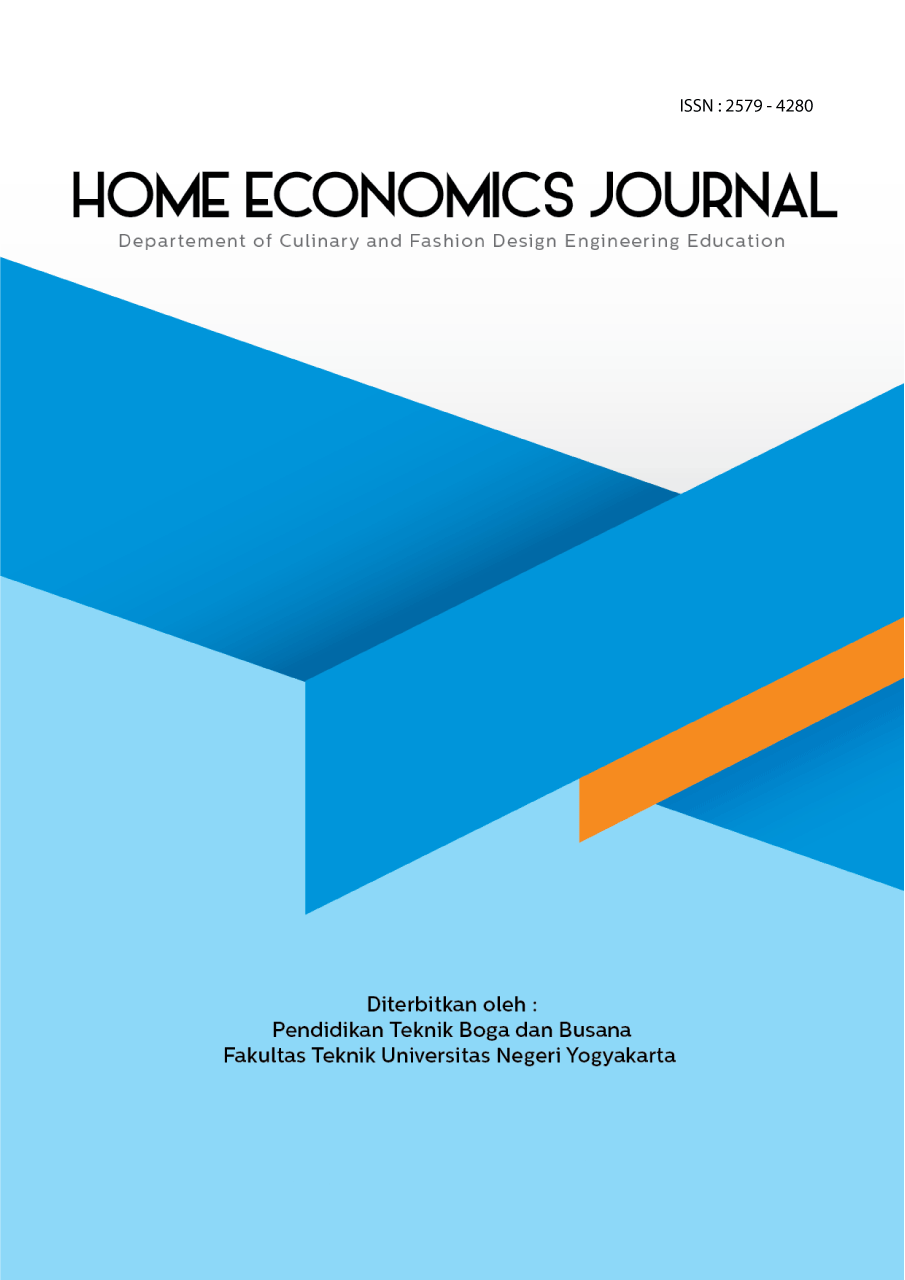COTTON DYEING USING ARECA CATECHU L SEED EXTRACT WITH COCONUT WATER MORDAN
DOI:
https://doi.org/10.21831/hej.v8i1.71364Keywords:
Areca, Coconut, Dyeing, MordantAbstract
References
R. Maharani, "Pengaruh Teknik Mordanting Terhadap Hasil Jadi Pewarnaan Alami Pada Jilbab Berbahan Sutera Dengan Ekstrak Gambir Menggunakan Teknik Tie Dye," J. Online Tata Busana, vol. 5, no. 3, 2016.
Q. Aini, N. Nuralang, A. D. Pradina, M. A. Yamin, A. Amanda, and D. R. Gusti, "Immobilisasi Nanopartikel Tembaga (Cu) dan Ekstrak Kulit Buah Pinang (Areca catechu) pada Kain Katun," al Kim. J. Ilmu Kim. dan Terap., vol. 9, no. 1, pp. 26–31, 2022.
M. Visalakshi and M. Jawaharlal, "Healthy Hues-Status and Implication in Industries–Brief Review," J. Agric. Allied Sci., vol. 3, no. 2, pp. 42–51, 2013.
A. F. Ahmad and N. Hidayati, "Pengaruh jenis mordan dan proses mordanting terhadap kekuatan dan efektifitas warna pada pewarnaan kain katun menggunakan zat warna daun jambu biji Australia," Indones. J. Halal, vol. 1, no. 2, pp. 84–88, 2018.
P. Lestari, "Ekstraksi Tanin dari Daun Alpukat (Persea americana Mill.) sebagai Pewarna Alami (Kajian Proporsi Pelarut dan Waktu Ekstraksi)." Universitas Brawijaya, 2014.
N. Fitrihana, "Proses Penyempurnaan Tekstil." PKK FT UNY, Yogyakarta:, 2014.
N. Nurmaini and A. Adriani, "Perbedaan Hasil Pencelupan Menggunakan Zat Warna Alam Eksrtak Sabut Kelapa Muda dan Ekstrak Sabut Kelapa Tua Pada Bahan Katun Dengan Mordan Air Kelapa," J. Kapita Sel. Geogr., vol. 2, no. 9, pp. 149–164, 2019.
N. N. Kristina and S. F. Syahid, "Pengaruh air kelapa terhadap multiplikasi tunas in vitro, produksi rimpang, dan kandungan xanthorrhizol temulawak di lapangan," J. Littri, vol. 3, no. 18, pp. 125–134, 2012.
G. Poespo, "Pemilihan bahan tekstil," Yogyakarta: Kanisius, 2005.
A. Jaedun, "Metodologi penelitian eksperimen," Fak. Tek. UNY, vol. 12, 2011.
P. Irawan, "Logika dan prosedur penelitian," Jakarta: Stia-Lan, 1999.
M. Ramanto, "Pengetahuan Bahan Seni Rupa dan Kriya," Univ. Negeri Padang, 2007.
Budiyono, Kriya Tekstil SMK Jilid I. Jakarta: Direktorat Sekolah Menengah Kejuruan, 2008.
S. Nugroho, Manajemen warna dan desain. Penerbit Andi, 2015.









